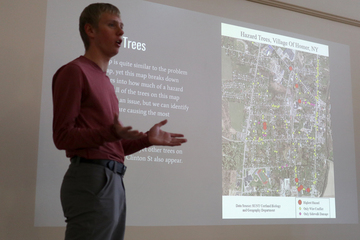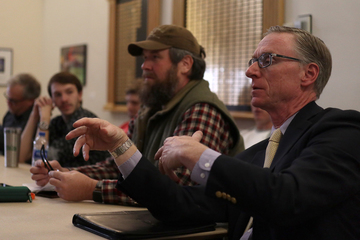
11/19/2019
Green spaces in the village of Homer, N.Y., may soon look a little different, thanks in large part to the effort of a group of SUNY Cortland students.
A Common Problem Pedagogy Project on campus linked students in a remote environmental sensing class led by Associate Professor Christopher Badurek of the Geography Department and those in a tree biology course with Professor Steven Broyles of the Biological Sciences Department.
Their task? To combine their expertise and complete a tree survey in Homer that would allow village officials to reassess future planting and removal initiatives.
Throughout the fall semester, students traveled to Homer and digitally catalogued trees in public spaces, including parks and along sidewalks. This data, which included the location of the trees as well as the specific species located in the village, led to recommendations and conclusions from the students.
Those findings, including GIS maps and analysis conducted by the students, were presented on Nov. 14. Village Mayor Hal McCabe said he was thrilled to come away from the meeting with information he will be able to bring to Homer’s Village Board of Trustees.

“We have a robust tree budget of about $50,000 a year for removal and planting,” McCabe said. “We know we have a real biodiversity issue, but this data is going to be super valuable to us to figure out what we need to do and what we need to plant.”
Of the trees catalogued by Cortland students, 62.8% are maple trees, meaning the village has a monoculture that leaves it vulnerable to pests and disease. That problem is compounded on the village green, where 91% of trees fall within the Acer, or maple, genus.
In addition to potential problems with pests and disease, maple trees are more likely than other types of trees to uproot sidewalks and shed branches or overturn during windstorms or after heavy icing.
That’s not to mention leaf-raking and collection for homeowners and the village’s public works.
Students proposed a number of other species the village could plant to increase diversity while maintaining the many positives that trees provide in densely populated areas. These include environmental benefits, improved property values and general public health.
For Ben Rozwod, a senior geographic information systems (GIS) major from Camillus, N.Y., the experience was valuable in expanding his understanding of the application of his chosen field of study.
He was also thankful for the knowledge of his counterparts in biology.
“My expertise certainly isn’t identifying trees,” Rozwod said. “I look at a tree and I’m like, ‘I don’t know what that is,’ but my group members had that part down. It was a cool experience to walk around and see what’s what.”
Cameron Halby, a senior conservation biology major from Cross River, N.Y., was excited to see Mayor McCabe taking notes during and asking questions after his presentation. That his recommendations for increasing tree diversity in Homer may ultimately be used by the village in future planting efforts made this a very tangible example of how conservation biology works in the field.
“It’s really cool to do work that involved going out and actually doing something for people and providing some benefit,” Halby said. “It’s not just an assignment for our own benefit, we’re really trying to help the community.”
It’s possible that public spaces in Homer will have a different look in the years to come. The new trees won’t simply be decorative. This will have been a very deliberative process that started through the ingenuity and hard work of a few dozen SUNY Cortland students.
“This is so helpful to us,” McCabe said. “I can’t overemphasize that.”